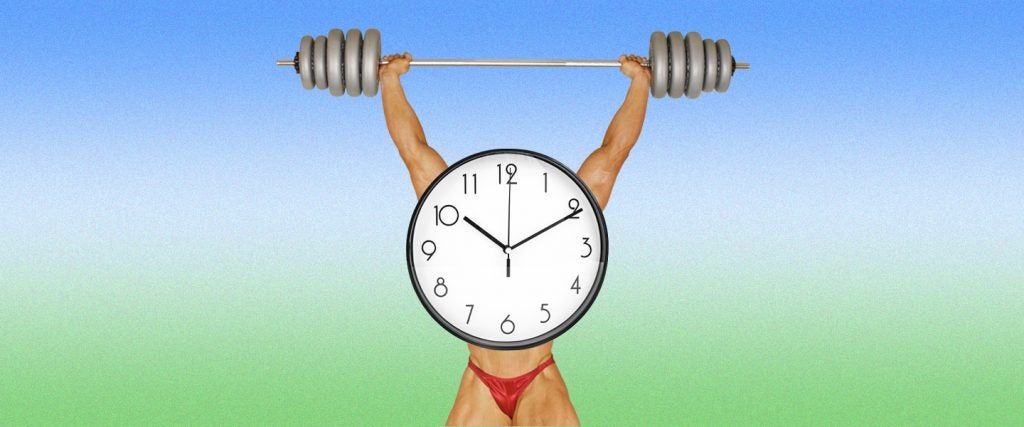Whenever I feel like making the excuse that I have no time to work out, I remember back to that hellish four-month period of my early 20s when I was working as a sales assistant at WOMC — a Detroit radio station — while simultaneously attending night school at the Specs Howard School of Media Arts. I pretty much had no time to eat, let alone to work out.
So I gave my body the only time I could — the 10 minutes I had between waking up in the morning and jumping in the shower. It was far from ideal, but it provided just enough of an opportunity for me to train every body part over the course of the week, and remain in some semblance of shape.
How did you manage to train so thoroughly within such a precariously small time window?
First of all, it’s important to note that this isn’t an optimal strategy for working out. But if you’re pressed for time like I was, the first three minutes of your 10-minute workout should be spent maxing out push-ups, pull-ups and crunches in rapid succession by devoting one minute to executing as many quality reps of each as you can. Once that’s over, you’re going to feel like you’ve been through a significant workout no matter what you do for the remaining seven minutes.
Speaking of those seven minutes, I’m going to assume that all you have at your disposal equipment-wise is a pull-up bar, a weight bench and two dumbbells that are never capable of holding more than 50 pounds of weight apiece.
If it’s chest day, flatten out your bench and execute one set of dumbbell bench presses with the heaviest weight you can press for at least 10 repetitions, leaving nothing in the tank for subsequent sets, because you won’t be doing any. Next, strip whatever weight you need to from those dumbbells, elevate the backrest of the bench and do one set of incline dumbbell presses to failure. From there, lower the weight and backrest one final time, and fry your pecs with a round of chest flies to failure. If there’s any time left on the clock, crank out one final set of push-ups until you couldn’t possibly complete another one.
For back day, you can throw in a second set of pull-ups, including those with an alternate grip like a neutral grip if that option is available to you. Then you can go into a set of bent-over dumbbell rows, followed by single sets to failure of one-arm dumbbell rows for each arm. Finally, if you promise to be careful and not use too much weight, you can do upright rows while squeezing at the top of the movement.
On shoulder day, begin with a dumbbell set of standing or seated military presses. After that, drop the weights and go through reps-to-failure progressions for your anterior delts, posterior delts and medial delts via shoulder raises. If there’s any time remaining, do another set of military presses to failure without adding any additional weight to the lightest set of dumbbells you just completed your final set of raises with.
For biceps and triceps, you can do chin-ups with a supinated grip, so that your hands are facing you and placing more emphasis on your biceps. From there, one set to failure of standing bicep curls is fine, followed by a quick drop in the weight and a single set of hammer curls until you can’t complete any additional reps. If you don’t own a dip stand, perform whatever variation of push-ups you’re capable of executing with your hands close together and your elbows in, even if it necessitates the placement of your knees on the floor. Next, a set of dumbbell tricep extensions from your back are ideal, followed by a set of tricep kickbacks.
Lastly, if you have the misfortune to be waking up on leg day, knock out two sets of goblet squats at somewhere between 15 to 20 reps, followed by a set of stepback lunges and then a trip around the room with walking lunges. Unless you’re training for something very sport-specific, these few sets will be of sufficient strain to challenge your legs and prompt gains in strength and endurance.
Man, that’s a hell of a sprint to put your muscles through every morning!
Indeed.
If you can reach the point where you can habitually execute even 50 push-ups in one minute and 10 pull-ups in the same span of time — and you can consistently churn these numbers out five times a week — you’re doing hundreds of pull-ups and more than 1,000 push-ups each month (with annual totals extrapolating out to more than 2,000 pull-ups and 12,000 push-ups). Those numbers are every bit as impressive as they sound.
But most of all, when it comes to fitness, consistency always wins, and your body will appreciate all of the hard work you did, even if you crammed it all into daily increments shorter than the time it takes to walk a mile.

